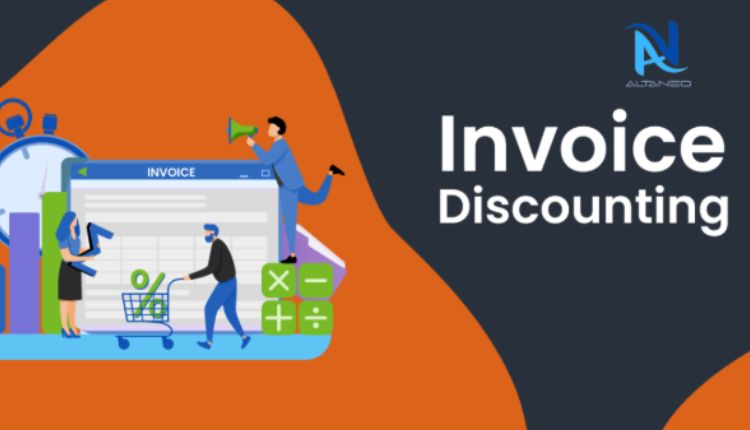
cash
Invoice discounting is a financial tool that allows businesses to unlock working capital without waiting for customer payment. It does that by freeing cash that has been held up in unpaid bills. Businesses can monitor their customer base and sales ledger while maintaining a healthy cash flow by using invoice discounting. By receiving a percentage of the invoice amount, usually within 24 to 48 hours, businesses can carry on with everyday trade and business expansion activities. For businesses trying to plug cash flow gaps, tide over seasonal cyclicities, or capitalize on new opportunities without taking long-term debt, invoice discounting services represent an effective go-to financial tool. Let us know more about invoice discounting for businesses, different types of invoice discounting, the role of technology, a few examples, and benefits for businesses.
What is Invoice discounting?
Companies often employ invoice discounting, a form of short-term borrowing, to boost their cash flow. They can get an advance from a lender or a financial institution, usually up to 80–90% of the invoice amount by submitting their unpaid bills as a collateral. Once the customer settles the invoice, the company receives the remaining amount excluding the fees and interest charged by the lender. Unlike factoring, where the lender takes over the collection process, invoice discounting lets the business maintain control over its sales ledger and customer relationships.
You may find invoice financing particularly useful if your business operates on long credit durations, i.e., from 30 to 90 days. It can help you bridge the gap between issuing an invoice and collecting the payment. If your business is in the growth stage, invoice discounting services could be attractive for you because it provides immediate access to working capital without having the need to borrow money from traditional channels. Since the funding is tied to sales and invoices, the amount of working capital unlocked increases with the growth of the business, making invoice discounting a flexible financing solution.
Types of invoice discounting
There are multiple types of invoice discounting that are designed to cater to various business models. Common types of this financing mechanism are confidential invoice discounting, disclosed invoice discounting, selective invoice discounting, and whole turnover invoice discounting. All these types differ in visibility, flexibility, and commitment levels and as a business owner, you need to know each of these types in depth in order to determine their suitability to your business needs.
Confidential invoice discounting
You can use this type of invoice discounting to borrow against unpaid invoices without informing your customers. Your company continues to manage its sales ledger and collects payments as usual, preserving the appearance of financial independence. If you are very much concerned about maintaining customer relationships and reputation, you may find this type of invoice discounting suitable. Lenders may require your company to have a robust credit control process and strong business capability since it depends on your business to ensure timely payments.
For instance, if your company is a well-known distributor of FMCG brands, you would not want to let your wholesalers and retailers know that you are taking the help of some financing arrangement. This is because this may be seen as a sign of financial weakness on your part. Lenders would be willing to support you in this arrangement provided you have a robust credit control process and only deal with customers who make timely payments.
Disclosed invoice discounting
In this type of invoice discounting mechanism, the customer is aware of the arrangement. Invoices generally include a notice instructing payments to be made directly to the lending institution. This method is more transparent and may be easier to set up for businesses with less robust credit control systems. While this may reduce administrative burdens for the company, it can potentially affect customer perception, especially if the discounting is interpreted as a sign of financial instability.
When you are a new business, you would not want to institute strong credit control systems but would want to widen your customer base before pruning your customer list based on creditworthiness. In that case, disclosed invoice discounting will make sense for you as it can lower your administrative efforts.
Selective invoice discounting
In this short-term business financing, your businesses may access cash by selling individual unpaid invoices to a finance provider, rather than committing the entire sales ledger. So, it represents more control because you can choose the invoices to be financed. As a result, you usually receive a percentage of the invoice value upfront, often between 70% and 90%, with the remainder paid once the customer settles the invoice. It is also referred to as spot or single invoice discounting. If your business requires cash occasionally or operates on a seasonal basis, this form of financing may be suitable for you.
Whole turnover invoice discounting
This involves financing the entire sales ledger through a finance provider. If you opt for whole turnover invoice discounting, you have to submit all customer invoices on an ongoing basis. In return, you receive a large percentage of the invoice value upfront. The remaining balance, excluding fees and interest, is paid to you when the customer settles the invoice. By this arrangement, you get a continuous source of working capital that can help your businesses maintain a steady cash flow and support day-to-day operations. This arrangement is usually confidential and your customers will be unaware of the financing agreement. However, your business requires high invoice volumes along with strong internal credit control processes if you want to go for this type of invoice discounting.
The role of technology
The frontiers in invoice discounting have been explored by blockchain that represents the intermarriage of financing and technology. Blockchain creates a tamper-proof digital ledger where each invoice is recorded with a unique identifier and timestamp. Once an invoice is uploaded and verified on the blockchain, it cannot be altered or deleted. A smart contract on blockchain can release funds to the business once an invoice is verified, automatically repay the financier when the customer settles the invoice, and handle early repayment fees or interest calculations without manual intervention.
All relevant parties — businesses, lending institutions, and buyers — can access real-time, transparent information about invoice status and payments which leads to trust. Platforms for invoice discounting based on blockchain technology can function worldwide without depending on centralized banks or credit bureaus. For SMEs in developing nations who frequently have trouble obtaining traditional financing, this is extremely helpful. As you can see, blockchain technology has transformed the invoice discounting for businesses.
Some real-world examples of invoice discounting
Large Business
A business with a revenue of £3 million per annum improved its business cash flow using Confidential Invoice Discounting. This facility was provided by a major UK bank and allowed the business to access funding that grew with its turnover, unlike an overdraft facility which is often limited by the value of the security held by the bank.
Talent acquisition company
A talent acquisition company expanded its product portfolio by utilizing the invoice discounting arrangement of a lending institution.
Manufacturing Firm
A small manufacturing firm used an invoice discounting platform to improve its cash flow, resulting in a 20% increase in production capacity.
Tech Startup
The tech startup capitalized on new opportunities and expanded its business because of availing an invoice discounting arrangement.
Benefits to businesses for cash flow
The benefits of invoice discounting for businesses in cash flow management are immense. Some of those benefits are listed below –
Improved cash flow
You can deploy the funds associated with outstanding customer bills by utilizing invoice discounting. Even if your business has extended payment terms with your customers, you need not wait for the days outlined in those terms. Your company can pay for regular operational costs like payroll, rent, inventory purchases, and energy payments without taking additional loans. This helps your business run more efficiently and keeps liquidity even during times of heavy demand or late payments by shortening the cash conversion cycle.
No requirement for long-term debt
Invoice financing is usually backed by the invoices themselves, as opposed to conventional bank loans that require tangible assets as collateral. As a result, you do not have to earmark assets such as land, building, and machinery as a security. This is specifically useful if you do not have many physical assets and your business is asset-light, such as IT, consulting, or services. As a result, you can secure money without risking assets or private obligations. Invoice financing is not a kind of long-term debt and does not appear as a liability on your balance sheet. Investors and stakeholders will see your financial records as healthy, and your company’s borrowing capacity for future demands will be preserved.
Improved control and customer relationships
Invoice discounting allows businesses to maintain direct relationships with customers. Your customers are usually unaware that you have opted for a financing arrangement. And, your business continues to handle all aspects of payment collection. When you retain control, you can also manage your own credit control processes, allowing your business to choose how aggressively or diplomatically you chase payments. This is particularly useful in industries where customer relationships are long-term and sensitive. Being perceived as financially independent can also enhance your credibility in the industry.
Flexible and scalable financing mechanism
You can choose how much financing you need and when you need it, especially under selective invoice discounting. Your business is not tied to rigid credit limits or monthly repayments as they would be with traditional loans. As your business grows and the value of invoices increases, the available financing for you under invoice discounting naturally grows as well. So, the funding grows in proportion to your sales, which makes this arrangement a sustainable long-term solution that can support your business expansion without requiring traditional loans.
Conclusion
Invoice financing helps businesses in managing cash flow, reduce borrowings, and ensure daily business operations. It makes sure that your company has the necessary liquidity to pay for operating costs, make investments in expansion prospects, and adapt to shifting market demands by effectively closing time lag between issuing out invoices and receiving payments. Invoice discounting enables firms to keep control over their client connections, steer clear of long-term debt, and scale finance in accordance with sales, whether through selective or entire turnover arrangements. In the end, it improves financial flexibility and stability, allowing companies to function more effectively and competitively in both stable and unpredictable economic climates.







